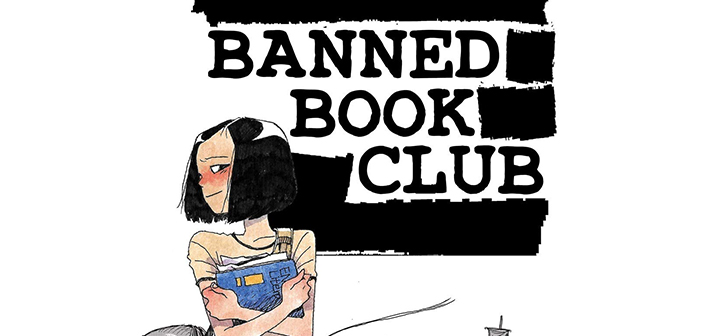
Kim Hyun Sook draws on personal experience for Banned Book Club, a look into a turbulent time in South Korean history and the importance of protest.
The Gwangju Uprising, May 18 to May 27, 1980. Government troops opened fire on students protesting the martial law imposed upon South Korea at the time, prompting local residents to take up arms and fight back. The official death toll sits at just 170 casualties, but the actual number is estimated to be far higher—between 1,000 and 2,000.
This was a turning point in a long-held struggle against authoritarianism in South Korea. For almost 20 years, from 1961 to 1979, the country was ruled by Park Chung-hee. He was responsible for major economic growth, but also severe civil rights abuses, to the point of imprisoning critics, having political opponents kidnapped and murdered, and amending the country’s constitution to extend his rule and allow further authoritarian powers. He was assassinated in 1979, paving the way for a military coup that installed Chun Doo-hwan as de facto ruler. He continued his predecessor’s dictatorial rule, using the spectre of a communist threat as justification for imposing a nationwide martial law and violently repressing any opposition to his rule.
Despite their efforts to suppress dissent, both Park and Chun’s regimes were met with protest and demands for democratic rule, particularly from university students. But they were also broadly popular—Park especially, who even today is regarded as one of South Korea’s most popular presidents, especially among older and more conservative groups. But the profile and visibility of Gwangju became a turning point, helping to spurn uprisings across the country and draw more public attention to the human rights abuses of Chun’s regime, eventually paving the way to the 1987 presidential election—the first peaceful transfer of power in South Korea’s history.

It’s against this backdrop that Banned Book Club sits, telling Kim Hyun Sook’s story of rebellion against an authoritarian military regime, based on her own experiences of that time. Taking place in 1983, Banned Book Club sees a young Kim starting her life as a university freshman. She knows little of the true nature of Chun Doo-hwan’s rulership—a common position, given the regime’s efforts to suppress the truth—and just wants to get a good education and a good job. She’s heard about the protests erupting at campuses all across the country and been warned to avoid them for her own safety, but they’re something she’s never seen or experienced herself.
Which makes her first day at college all the more shocking. A stand-off between protesters and police blocks the gates, and Kim’s only way to get to class is to fight through the tear gas and molotov cocktails being thrown around. The opening ceremony begins with the chancellor condemning the protest and students “throwing away their parents’ hard-earned money” in order to “join the commies”.
Kim’s eye-opening experiences continue when she joins the school’s masked folk dance team and book club. These seemingly innocent clubs are actually a front for organising protests and sharing books banned by the government—the likes of The Communist Manifesto, Rhee Young-hee’s Logic for an Era of Transition, the poetry of Kim Ji-ha, and Che Guevara’s The Motorcycle Diaries.

What follows is a journey of radicalization, as Kim learns the real truth that’s hidden from the government-sanctioned media and comes to see the importance of a fight for democracy. It’s a glimpse into a snapshot of South Korea’s history that touches on everything from the Gwangju Uprising to the Chun regime’s “3S” media policy—a focus on sex, sports, and screens as a way of distracting the populace from political reality. (As Kim’s new friends explain it: “People mad they can’t gather in public? Bring the Olympics so they can cheer for their country instead of against its leaders. Filmmakers complain that you’re limiting their political speech? Lower the regulations for on-screen nudity instead!”) It’s a look at the grim lengths a violent regime will go to to crush any sort of threat to its legitimacy.
It turns the lens the other way on occasion, too, to look at how protest movements can fracture from within or be exploited. To this day, across movements of all sorts, seemingly well-meaning allies use their influence within a space and the implicit trust that they’re “one of the good ones” to engage in predatory behaviour, often without even realising they’re doing it. And even when things aren’t quite as serious as that, the interpersonal politics and romantic developments can disrupt a group that is, by design, relatively structured and leaderless. Banned Book Club touches on all these things, too.
It’s not a book with a clean, neat ending where everything is all wrapped up and the heroes save the day, because that’s not how these things work. But it ends on a hopeful note, and one that really emphasises why protest is so important, even if it seems like the world is against you. Such bold actions may seem to alienate the masses at first, especially with an authoritarian government’s propaganda arm doing everything it can to discredit the movement. And though it may not be many at first, there are people who you’ll reach, who’ll pay attention, and the cause will grow stronger. Change may be slow and incremental, but if you fight for it, it will come.

Banned Book Club is written by Kim Hyun Sook and Ryan Estrada, with art by Ko Hyung-Ju. It’s available now from Iron Circus Comics.
A review copy was provided to Shindig by the publisher.

